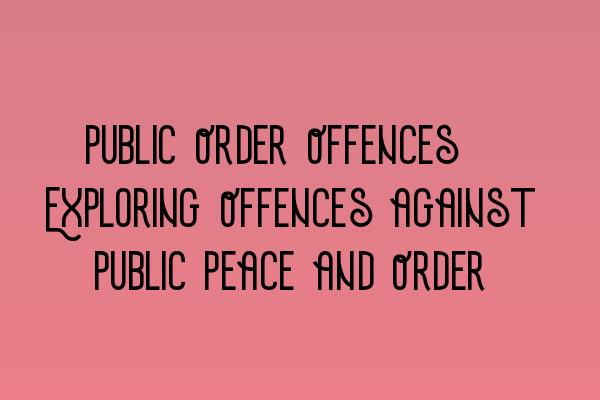Public Order Offences: Exploring Offences against Public Peace and Order
Welcome to the SQE Criminal Law & Practice Law UK blog, where we provide valuable insights into various aspects of criminal law. In this post, we will be exploring public order offences and shedding light on offences against public peace and order. If you are studying for the SQE exam or simply interested in criminal law, this article is for you.
Understanding Public Order Offences
Public order offences, as the name suggests, involve violations of laws and regulations that aim to maintain public peace and order. These offences encompass a wide range of behaviors that may disrupt the tranquility of public spaces or cause harm to individuals or the community as a whole.
Common public order offences include but are not limited to:
- Disorderly conduct
- Rioting
- Harassment
- Threatening behavior
- Intimidation
- Public nuisance
It is essential for legal professionals to have a thorough understanding of these offences in order to effectively represent their clients and maintain a just society.
Offences Against Public Peace and Order
Offences against public peace and order can have serious consequences and may result in criminal charges. These offences are categorized based on their severity, with some being considered minor infractions while others are considered more serious crimes.
One such offence is disorderly conduct, which involves engaging in behavior that causes a disturbance or provokes others in a public place. Disorderly conduct encompasses activities such as fighting, shouting, or using offensive language in public. It is important to note that disorderly conduct charges can vary in different jurisdictions, so it is crucial to consult the specific laws of the relevant jurisdiction.
Rioting, on the other hand, involves the participation in a violent public disturbance by an assembled group of individuals. Rioting often leads to property damage and poses a significant risk to public safety. Legal consequences for rioting can be severe, and individuals found guilty may face imprisonment and hefty fines.
Harassment and threatening behavior also fall under offences against public peace and order. Harassment refers to persistent and unwanted conduct that causes distress or alarm to the victim, while threatening behavior involves making threats to cause fear or harm to another person. Both these offences can have a profound impact on the well-being of individuals and the overall stability of the community.
Another offence that is closely related to public order is public nuisance. Public nuisance involves activities that interfere with the reasonable enjoyment of a public space or cause harm to the public. Examples of public nuisance may include noise pollution, obstructing public roads, or causing environmental hazards. Individuals found guilty of public nuisance may be subject to legal action and penalties.
Conclusion
Public order offences are a crucial part of criminal law, as they play a vital role in maintaining public peace and order. It is imperative for legal professionals to have a comprehensive understanding of these offences in order to effectively navigate the legal system and protect the rights of their clients.
If you found this article informative, you may be interested in other related articles on our blog:
- Demystifying the Solicitors Qualifying Examination Format
- LLC Formation Made Simple: Step-by-Step Guide for UK Entrepreneurs
- Business Regulations in the UK: A Comprehensive Overview
- Preparing for the SQE Exam: Strategies and Resources for Success
- SQE Workshops and Webinars: Accelerate Your Exam Preparation
Be sure to check out these articles for further insights into legal topics related to SQE exams, business regulations, and more. Thank you for reading!
